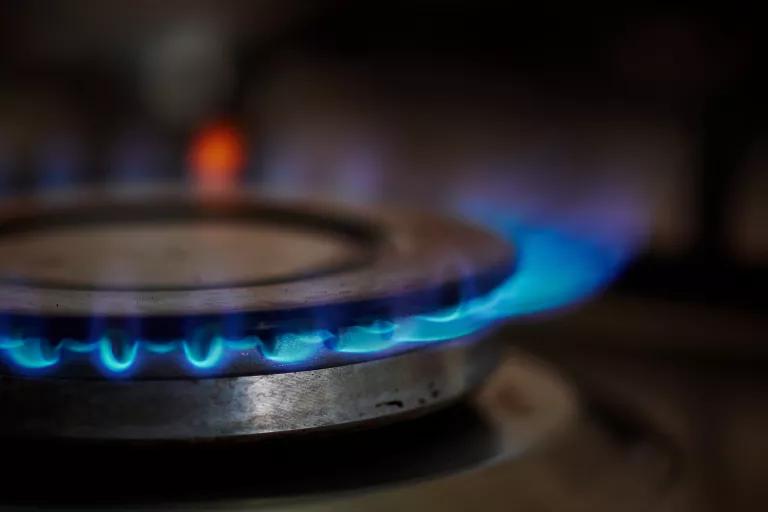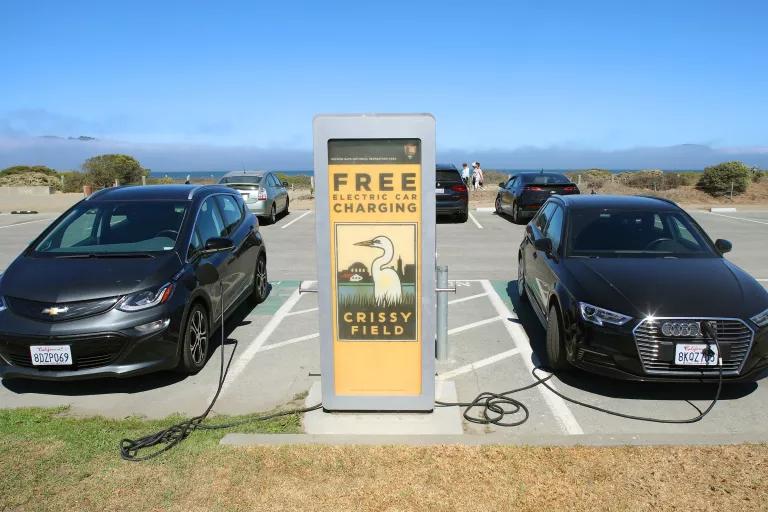How to Ditch the Biggest Fossil Fuel Offenders in Your Life
Here are some high-impact ways to reduce your personal use of oil and gas and gain a little energy independence.

Getty Images
The single-most important step we can take to help address global warming and save this planet is swearing off fossil fuels. It will also require seismic shifts in all of our systems, from how we grow food to how we travel and build homes. And we won’t be able to achieve true energy independence until we see full buy-in from our elected officials.
But we can begin to take action in our lives now. Here are some high-impact ways to root out fossil fuels from your own life—and advocate for the policy shifts that will allow everyone else to do the same.
Switch your home off fossil fuels.
Most homes still run on fossil fuel–based dirty energy. Fossil fuel combustion attributed to homes and buildings accounting for a significant 13 percent of total U.S. greenhouse gas emissions. Flipping the switch to clean energy—including through investing in new appliances and modes of heating and cooling—can take time and depends on your budget, the existing infrastructure of your building, and whether you rent or own. But in the long run, doing so can add up to big savings in both emissions and energy costs. (You can multiply your returns by prepping your home with some standard energy efficiency upgrades, like installing insulation and sealing leaky doors and windows.)

A gas-burning stove leaks methane gas even when off.
Getty Images
Start by investing in a clean energy electricity provider.
- Option 1: Install solar panels
For homeowners who are ready to make a bigger investment up-front (and live on sunny-enough land), you can install your own solar panel system. Before you get started, estimate the solar (and savings) potential of your roof; Google’s Project Sunroof will help you with that. You’ll also want to compare installation quotes at sites like EnergySage. The good news is that the cost of installing solar has dropped by more than 70 percent in the last decade and continues to go down. And an expansion of the Residential Clean Energy [Tax] Credit is helping to make it more affordable for more people while also shortening the time it takes to see a return on your up-front investment. - Option 2: Modify your existing energy plan
For a lower-cost investment option, you can call your electric utility provider and ask about switching to a renewable power plan, which works for renters too. Your home won’t be directly powered by clean energy. Rather, these plans work by allowing utility customers to pay a slight premium for electricity from a partnered clean energy supplier, which feeds into the same grid that provides your current electricity. By participating in this plan, you’re boosting the overall percentage of clean energy generation on the electricity grid and reducing reliance on fossil fuels. - Option 3: Participate in a community solar project
If a renewable energy plan like this isn’t available through your utility company, look for a nearby community solar or wind project, which allows homeowners or renters to buy into a larger, collectively owned renewable energy project. In some cases, residents will lease a certain number of solar panels for a set period. These, too, feed energy into the main grid that provides your current electricity.
Swap out any gas-powered appliances for ones that can be plugged in.
As the electric grid becomes increasingly powered by renewable energy, any appliances that run on electricity also become cleaner. That’s why we eventually want to switch out all fossil fuel–powered equipment—like gas furnaces and water heaters, which continue to emit for their whole life cycle—for ones that plug in. This process, known as building decarbonization, can take the most time, explains NRDC senior energy policy advocate Lauren Urbanek, particularly if your building’s infrastructure was built for natural gas. Because overhauling everything at once can be expensive, Urbanek suggests making swaps as things are ready to be replaced. Alternatively, go for the highest-impact items first. However you choose to proceed, be sure to take advantage of the Energy Efficient Home Improvement [Tax] Credit provided through the IRA, which will refund you up to $2,000 per year for certain energy-efficient appliances.
- Modern electric heat pump: Most of your fossil fuel consumption will come from your gas-powered heating and cooling systems, as well as your water heater. Electric heat pumps are super-efficient, electric alternatives that can be used for space heating and cooling, as well as water heating. Recent research estimates that a typical U.S. home can cut its heating-related climate pollution by up to 72 percent by swapping out a gas-fired furnace for an electric heat pump. Even if you only need to replace your air conditioner, Urbanek suggests replacing your gas-powered furnace, too, because the heat pump functions as both. It’s a major upgrade that will run into the thousands, but you’ll get the biggest bang for your buck on cost and carbon savings across the life of the new systems.
- Induction stove: These are electric but they heat your food in an entirely different way than the red-ringed, slow-cooking electric stoves you’ve seen in the past. Induction stoves use copper coils to create a magnetic current, which allows them to pass heat directly to your pots and pans, rather than to the stovetop and then to the cookware. As a result, your cookware is more evenly heated and less energy is lost along the way. They work so well that many professional chefs choose induction cooking in their home kitchens. They also happen to be super-easy to clean and allow for more precise temperature control. They’re a clear step up from cooking over a gas flame, which leaks methane gas even when off and emits health-harming carbon monoxide and nitrogen dioxide when in use. If your kitchen is a tight space or you’re not quite ready to make a big investment, there are options in smaller sizes as well.

Drying racks are a great zero-carbon option.
Enes Evren/Getty Images
- Efficient electric washer and dryer: New models of high-efficiency, electric washer and dryers come with features like load-sensing technology, which reduces the amount of water used, or a higher spin speed to reduce the time it takes to dry. Another option is the new heat pump dryer, which works like a dehumidifier and doesn't need to vent hot air, which means it uses a fraction of the energy compared to standard dryers. While these appliances still cost more up-front, they can save both energy and money in the long run. (For a zero-cost and zero-carbon drying option, go old-school and hang a clothesline.)
One more note: Check to see if you have outlets with the necessary power. While smaller appliances can run from standard 120-volt outlets, larger appliances like dryers or ovens typically need 240-volt outlets.
If you’re unsure, ask your building management or have an electrician check. And if you’re buying a new home, it’s worthwhile to inquire about electrification and state your preference up front. “Just asking shows building owners and developers that the demand is there for that kind of infrastructure,” Urbanek says, “and that can go a long way.”

A free electric car charging station near Crissy Field Center in San Francisco
Liz Hafalia/The San Francisco Chronicle via Getty Images
Ditch fossil fuels when you travel.
Sky-high gasoline prices are no doubt a motivator to rid your daily commute of fossil fuels. And the alternatives are getting better.
- Electric cars: Zero-emission vehicles shrink our carbon footprint in half and get rid of deadly tailpipe emissions that harm our health and air quality. Not to mention, they’re fun to drive: EVs are virtually silent, handle nicely, and produce instant torque, making acceleration on the road fast and smooth. Dozens of new makes and models are coming out each year, but do check for tax incentives and rebates before you buy. Charging infrastructure is also being built out across the country, making EVs more practical for longer commutes. Resources like PlugShare can help you find nearby public charging stations (it also has an app).
- Public transportation: Opt for it whenever possible (bonus points for all-electric public buses or commuter trains). Zero-emission options like bicycling or walking are also good for your health. If you’re intimidated by commuting via bike, a free bike safety course can help you become more comfortable on the road. The League of American Bicyclists helps find one near you.
Advocate for policies that fight fossil fuels.
While consumer choices matter and can give momentum to powerful market changes, individuals alone can’t solve problems that are baked into systems. “Even if you live the greenest life that you can, policy changes are where the big shifts need to happen,” Urbanek says. “The good news is that individuals can absolutely affect policy.” And that really starts in your community.
- Vote: It’s the most powerful action you can take. Start by checking your voter registration is up to date at vote.org.

“Kayaktivists” hold up a "Choose Water, Not Pipelines" banner during a "pipeline resistance training camp" in 2017.
Tim Exton/AFP via Getty Images
- Oppose fossil fuel projects: Advocacy needs to happen between election days too. And fossil fuel infrastructure that’s headed to your community is a good place to fight the good fight. Past grassroots efforts, like the decade-long campaign to stop the notorious Keystone XL pipeline, have shown that no matter how fated a fossil fuel project seems, sustained public pushback can keep new fossil fuel infrastructure from being rubber-stamped.
- Call for green public investment: You can help wean the transportation system off dirty energy by urging your local, state, and federal representatives to increase public investments into electric vehicle and public transit infrastructure, and to support changes to the way cities grow. “People can advocate for more connectivity in their communities so that cities are more transit- and walking-friendly in the first place,” Urbanek says.
- Fight anti-electrification legislation: To address dirty energy in homes and buildings, you can speak out against anti-electrification legislation, which has already been passed in nearly two dozen states. Backed by gas industry interests, these bills make it illegal to require new buildings to run on green energy. “It’s couched as protecting consumer choice,” Urbanek says, “but it’s fancy packaging for preventing electrification policies.” If an anti-electrification proposal is pending near you (something that you can often find out about by keeping up with a local sustainability group), weigh in during a hearing or through public comments.
Across the board, countless policies at every level of government will need to shift if we’re to wean ourselves off dirty fossil fuels for good. Urbanek suggests not only reaching out to your representatives when you oppose a pro–fossil fuel measure but also to thank them for supporting policies that will usher in the clean energy future we need.
This story was originally published on May 18, 2022, and has been updated with new information and links.
This NRDC.org story is available for online republication by news media outlets or nonprofits under these conditions: The writer(s) must be credited with a byline; you must note prominently that the story was originally published by NRDC.org and link to the original; the story cannot be edited (beyond simple things such as grammar); you can’t resell the story in any form or grant republishing rights to other outlets; you can’t republish our material wholesale or automatically—you need to select stories individually; you can’t republish the photos or graphics on our site without specific permission; you should drop us a note to let us know when you’ve used one of our stories.

How You Can Stop Global Warming
A Consumer Guide to the Inflation Reduction Act
What Are the Solutions to Climate Change?
How You Can Stop Global Warming
A Consumer Guide to the Inflation Reduction Act
What Are the Solutions to Climate Change?
How You Can Stop Global Warming
A Consumer Guide to the Inflation Reduction Act
What Are the Solutions to Climate Change?
How You Can Stop Global Warming
A Consumer Guide to the Inflation Reduction Act